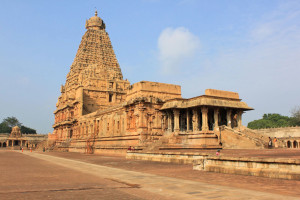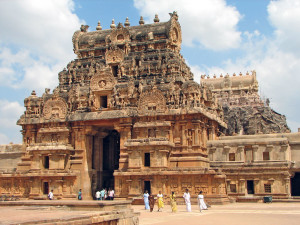Brihadisvara (Brihadeeswara) temple located in the town of Thanjavur in the state of Tamil Nadu in India is an exemplary production in the Dravidian style of temple architecture.
Brihadisvara temple was built by one of the greatest emperors, king Rajaraja Chola of the Chola dynasty. The main deity of the temple is Siva Linga. The most celebrated Saiva temple of all, appropriately called Brihadisvara and Daksinameru, is the grandest creation of the Chola emperor Rajaraja (AD 985-1012). It was inaugurated by the king himself in his 19th regal year (AD 1009-10) and named it after himself as “Rajesvara Peruvudaiyar”. As we gather from the inscriptions running throughout the plinth, the king, on the 257th day of the twenty-fifth year of the reign (1010 A.D) presented a gold-covered finial to be planted on the top of the Vimana of the temple.
Surrounded by two rectangular enclosures, the Brihadisvar (built from blocks of granite and, in part, from bricks) is crowned with a pyramidal 13-storey tower, the vimana, standing 61 m high and topped with a bulb-shaped monolith. The walls of the temple are covered with rich sculptural decoration. The Sivalinga of Sri Brihadisvara is probably the grandest in existence.Architecture of Brihadisvara Temple
Architecturally, it is the most ambitious structural temple built of granite. Brihadisvara Temple is within a spacious inner Prakara of 240.90 m long (east-west) and 122m broad (north-south), with a Gopura at the east and three other ordinary ‘Torana’ entrances one at each lateral sides and the third at rear. The Prakara is surrounded by a double-storeyed ‘Malika’ with ‘Parivaralayas’.
f
Fine arts were encouraged in the service of the temple. The sculptures, the paintings in the surrounding passages of the sanctorum and even the inscriptions in elegant Chola Grantha and Tamil letters are a proof of the great art that flourished under Rajaraja.
Dance and music were greatly cultivated and were equally employed to serve the temple. Every evening it was at once an entertainment and a ritual that the towns-folk, assembled in the mandapa, witnessed and enjoyed during the ceremony of the waving of lights and the chanting of the Veda and Devaram hymns.
The temples of Devi near the Nandi-mandapa and of Subramanya were later added later, the former during the time of Konerimaikondan (a Pandya of the 13th century ) and the latter during the Nayaka period in the 17th century. The shrine of Ganesa and the mandapa of Nataraja are also later additions. The temple of Subramanya has exquisite carvings and is an excellent example of South Indian temple-architecture in the late medieval period.









